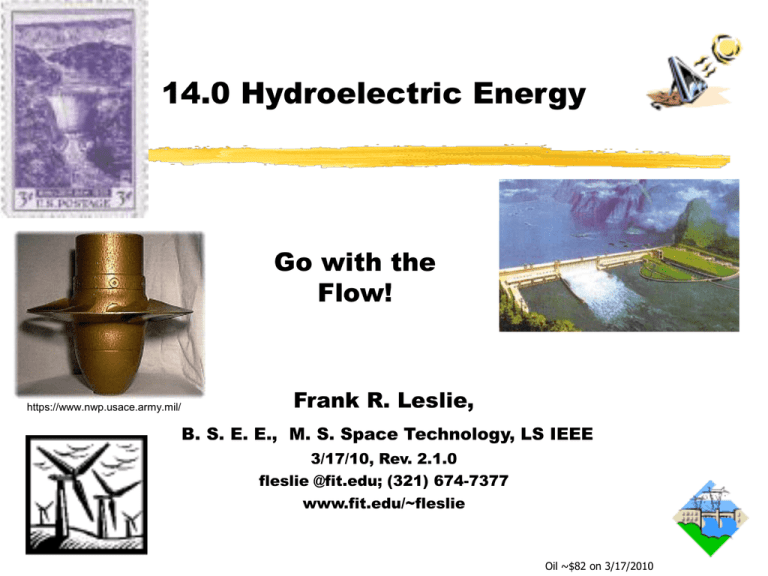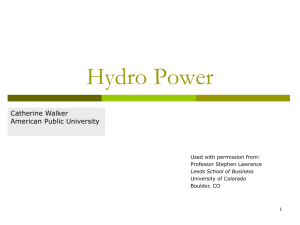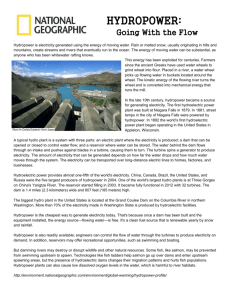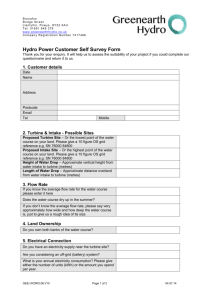RE140Hydro - Access Florida Tech
advertisement

14.0 Hydroelectric Energy Go with the Flow! https://www.nwp.usace.army.mil/ Frank R. Leslie, B. S. E. E., M. S. Space Technology, LS IEEE 3/17/10, Rev. 2.1.0 fleslie @fit.edu; (321) 674-7377 www.fit.edu/~fleslie Oil ~$82 on 3/17/2010 In Other News . . . Chile will build a $3.8 billion hydro dam in Patagonia Backpack power plant (at right) DOE Announces Funding Opportunity for Marine and Hydrokinetic Technology Development, March 10, 2010 The U.S. Department of Energy (DOE) today announced its intent to issue a Funding Opportunity Announcement (FOA) for the advancement of marine and hydrokinetic technology. The FOA, entitled "Marine and Hydrokinetic Technology Readiness Advancement Initiative," will solicit applications for projects to advance the development of technologies that generate renewable electricity from waves, currents, tides, freeflowing rivers, and the ocean's thermal energy. Technologies at various levels of development will be evaluated based on metrics and guidelines established by DOE, and funding will be competitively awarded to a variety of projects. For more details, please view the Notice of Intent on the FedConnect Web site. (Search by Issuing Office Golden.) 100317 14 Overview: Hydropower Hydropower is a conventional energy form since it has been in existence so long Hydro falls within the renewable category since solar energy powers the rainfall cycle; some people want to remove (breach) dams to get rid of blockages to travel, to see the canyon, and to stabilize river flows The latter makes for controversy in salmon areas as dams may interfere with spawning [ed. note: Do those who want salmon to “swim free” eat salmon steaks in Berkeley, California fern-garden restaurants?] Only ~10% of potential water flows are currently used Georgia Tech researching tidal flows http://www1.eere.energy.gov/windandhydro/projects.html#mhtma 100317 14 Overview: Hydropower in the US https://www.nwp.usace.army.mil/hdc/corpshydro.htm Hydropower is primarily commercial in the US, and supplies 13% of total electrical generation While fossil-fired steam holds the highest rank, hydro is #3, second only to nuclear power 050322 http://www.corpsresults.us/hydro/default.htm 14.0 About This Presentation 14.1 History 14.2 Dam Energy 14.3 Sources of Water Power 14.4 Waterwheels 14.5 High-Speed Turbines 100317 14.6 Physics of Operation 14.7 Power vs. Head and Flow 14.8 Issues and Trends 14.0 Conclusion 14.0 US Hydropower 100317 interestingenergyfacts.blogspot.com 14.1 History of Water Power Greek poet Antipater (400 B.C.) refers to energy of falling water www.calpoly.edu/~cm/ studpage/ashan/ ~200 B.C.E., Egyptians were grinding grain with horizontal water mills Technology from the Persians (Iran/Iraq), who may have gotten it from China By the First Century, the wheels were turned to operate vertically (horizontal axis) at much better efficiency About 1800, water mills were common in Europe and New England In 1820s, Benoit Furneyron invented the turbine First electric power of 12 kW on Fox River, Appleton Wisconsin, 1882 www.calpoly.edu/~cm/ studpage/ashan/ 050322 14.2 Hydroelectric Energy (Dams) The solar distillation of ocean and surface waters and ground moisture produces rain that stores potential energy above sea level The impoundment of this water energy has long been used for generation of electricity Hydro dams were commonplace in the 1930’s, but many have fallen into disuse and were removed Once installed, these systems produced low cost electricity 030322 World's largest storage dam, Uganda's Owen Falls Dam. The hydroelectric station at the dam supplies most of the electricity requirements of Uganda, and parts of Kenya. (Photo:Faculty of Engineering, Kasetsart University, Thailand) Newhalem WA Gorge Plant; photo: Leslie, 2002 14.2 Hydroelectric Energy (continued) Florida has only two small hydropower plants near Georgia (C. H. Corn Hydroelectric and Jim Woodruff Dam), while the Pacific Northwest relies heavily on Columbia River hydropower for cheap electricity (Number 3 is the 3 to 16 watt system at Florida Tech) Most useful sources have been exploited years ago Dams are under attack by environmentalists who want water unhindered for fish passage, recreation, and for endangered species --- some of them claim hydro is not renewable (but it is) Impounded waters reduce ocean rise, prevent loss of life and property loss from floods http://talgov.com/citytlh/utilities/electric/corn.html www.srh.noaa.gov/tlh/cpm/ chattahoochee.html 100317 14.3 Sources of Water Power Impoundments such as dams hold back water to increase the head and store water for use in droughts High pressure turbines use high pressure streams and relatively lower volumes of water “Run of river” dams don’t store water in a deep reservoir but merely channel it to the turbines These turbines run with large volumes and low pressures Many dams control flooding downstream and have no hydropower generators My hometown; Dayton, Ohio, flood of 1913 http://www.miamiconservancy.org/Flood_Protection_&_Water_Management/Great_Flood_of_1913/ 090317 14.3.1 Chief Joseph Dam in Washington Run of river dam on Columbia River, Oregon Produces 2069 MW; Grand Coulee is 6465 MW! The other kind of dam is the storage dam with a high reservoir Photo by F. Leslie, 2002 090317 14.3.1.1 Chief Joseph Dam “Fish Ladder” Fish ladder to allow fish to bypass the dam and turbines Federal fish counters identify and tally them Photo by F. Leslie, 2002 050322 14.3 Electrical Switch Yard at a Dam Bonneville Dam upstream from Portland Energy from the turbines is collected on bus bars for transmission After a transformer raises the voltage (and decreases the current), the high lines connect to the red-and-white tower’s insulators to be connected into the grid Photo by F. Leslie, 2002 050322 14.3 Utah Dam Electrical Transformers High power has three phases, thus three singlephase transformers are used for each generator’s output 060319 http://www.shoestringbooks.com/Utah/Dam-power%20converters.jpg 14.4 Water Wheels Types of water wheels are based upon where the water strikes it Pitchback – water drops from top and is deflected backwards to fall back towards the dam Overshot – shoots over the top onto the wheel; the usual kind Breastshot – strikes about 50% to 80% of height of the near side of the wheel Undershot – pushes underneath and need not be more than immersed in a stream Waterwheels turn slowly compared with turbines one to fifty rpm With no load, the Florida Tech wheel turns 10 turns in 11 seconds 100317 14.4.1 Water Wheels: Pitchback http://www.whitemill.org.uk/z0028.htm Note the difference in direction of the water flow A containing surround structure could force the water against the wheel as it falls and increase the weight of the water in the wheel 050322 14.4.2 Water Wheels: Overshot The water flows across the top of the wheel, pushing it forward, but also partially filling the buckets so that the weight pushes downward to turn the wheel The inertia of the water helps turn the wheel only slightly since it doesn’t flow very fast A very fast flow would be needed to get kinetic energy 100317 http://inventors.about.com/gig/dynamic/offsite.htm?site=http://www.geocities.com/Athens/Forum/3807/features/watermills.html 14.4.3 Water Wheels: Breastshot Note the contoured channel or surround at the bottom of the wheel that holds the water into the wheel Water Flow The water strikes the wheel about mid-way up so the inertia and the weight of the water push the wheel around 090317 14.4.4 Water Wheels: Undershot The undershot wheel is simply placed in a stream with the bottom of the wheel pushed by the current Works well where there is little depth and no head Inefficient, but works where others won’t Can be on a small boat anchored in a stream 080317 http://inventors.about.com/gi/dynamic/offsite.htm?site=http://www.geocities.com/Athens/Forum/3807/features/watermills.html 14.5 High-Speed Commercial Turbines Types of turbines (next) Francis Bulb Kaplan Pelton 090317 14.5.1 Energy Extraction: Francis Turbine Water flows through the runner to spin the turbine 030323 14.5.2 Energy Extraction: Bulb Turbine Ampair's Aquair UW submersible propeller turbine 30 ft diameter 0.8 ft diameter Small versions of the bulb turbine can be lowered into a stream by hand to power a remote home http://www.hitachi.co.jp/Div/hitachi/hydraulic-turbine/BULB.htm 050322 14.5.3 Energy Extraction: Kaplan Turbine A Washington state dam turbine runner at The Dalles My wife in red shirt is 5’ 2” tall Photo by F. Leslie, 2002 050322 http://www.hitachi.co.jp/Div/hitachi/hydraulic-turbine/KAPLAN.htm 14.5.4 Energy Extraction: Pelton Turbine These double cups catch the water from the input water jets and redeflect it for maximum thrust to spin the rotor; the water falls away Pelton turbines are popular for microturbines producing remote home energy http://www.galeforce.nireland.co.uk/Water/water.htm http://www.hitachi.co.jp/Div/hitachi/hydraulic-turbine/others.htm 050322 14.5.5 Small Harris hydro generator for home use An automotive alternator is rewound to generate the required voltage at a low speed, as car alternators run at 5,000 to 18,000 rpm A Pelton wheel turbine is spun by four valved nozzle flows http://www.realgoods.com/renew/shop/product.cfm?dp=1200&sd=1201&ts=1017101 090317 14.6 Physics of Turbine Operation Head of water: height above turbine; the greater the head, the more pressure at the turbine entrance Flow rate: mass flow provides the energy transfer Energy extraction: efficiencies of various turbine types drive the selection vs. cost of the installation HP input from water = W•Q•H/33000, where W is 62.42 pounds per cubic foot Q is flow in cubic feet per minute And H is the head in feet (1 hp = 33000ftlbs/minute = 550 fl-lbs/second) Electrical Efficiency = V•I•(100%)/(Hpin•(746W/hp)) Overshot wheels average ~50% since the kinetic energy turns the wheel 100317 14.6.1 Turbine/Generator Description 400MW Pump-Turbine for Kazunogawa power station, Japan. 050322 A small exciter generator is at the top of the shaft and its energy drives the stator (stationary) coils of the large alternator The alternator (main generator of alternating current) is above the turbine on the same shaft The turbine at the bottom spins at a slow speed (~150 rpm) to move the rotor coils past the stator coils and generate at the desired frequency (60 Hz in the US; often 50 Hz overseas) http://www.hitachi.co.jp/Div/hitachi/hydraulic-turbine/PUMP.htm 14.6.2 A Typical Turbine Hall Tongland Turbine Hall, Kirkcudbright, Galloway The exciters are located atop the generators and drive the field coils of the generator 4 ft high by 8 ft diameter exciters on top Note 4 ft. handrails on generators Turbine areas are very noisy, requiring ear protection and radio intercoms 050322 http://www.freefoto.com/pictures/industry/hydro_electric/index.asp?i=56 14.7 Power vs. Head and Flow APPROXIMATE PIPE DIAMETER (mm) NET HEAD OR PRESSURE IN METRES OF WATER http://www.galeforce.nireland.co.uk/ 030307 WATER FLOW IN LITRES PER SECOND 14.7.1 Small Hydropower Hybrid 090317 http://www.absak.com/diagram/index.html 14.7.2 Home Hydro at Work http://www.homepower.com/files/homebrewhydro.pdf?search=water%20turbine 14.7.3 Hydro Plant Restoration Celeste and Chris Kruger dropping the Brockway Mills rotor through the hatch in the powerhouse roof. 090317 From the French River Land site in Massachusetts http://www.frenchriverland.com/ 14.8 Issues and Trends The optimum locations for major dams have already been exploited; many smaller dams have been opened Large dams are currently under attack by some who feel that they should be breached to “restore the natural river flows” and “to let the river run free” This lack of dams often led to massive floods and loss of life in the past Further large installations are unlikely, although many small stream systems are still being developed Droughts have reduced water flow in the Northwest, impacting the energy supply and increasing prices The reservoir behind large impoundment dams can generate GHG due to decomposition of plant material 050322 14.8.1 Issues and Trends Glen Canyon Dam is perhaps the most hated by radicals who want it destroyed so the river can “run free” This design won ASCE Outstanding Engineering Achievement Award for 1964 060308 http://www.shoestringbooks.com/Utah/default.htm 14 Conclusion: Hydropower The majority of logical hydropower sites were developed long ago There are still some dams in construction, like China’s Three Gorges 18 GW dam (final touches) Africa has only 7% hydro potential developed Hydropower in the US West was a result of President Hoover’s work program to increase employment during a depression and also to provide cheap electricity to spur commerce in the West Small hydropower on the scale of remote home energy is still developing Hydropower provides inexpensive electricity in the US Northwest, primarily from the huge Columbia River 070315 Olin Engineering Complex 4.7 kW Solar PV Roof Array Questions? 080116 14.A Appendix: Water Flow Estimation Depth over weir dam, inches Cu. ft per minute per in. of dam width 1 0.40 2 1.13 3 2.07 4 3.20 5 4.47 6 5.87 7 7.40 8 9.05 9 10.80 10 12.64 The weir could be a board with a horizontal slot cut in it 030323 References: Books Boyle, Godfrey. Renewable Energy, Second Edition. Oxford: Oxford University Press, 2004, ISBN 0-19-26178-4. (my preferred text) Brower, Michael. Cool Energy. Cambridge MA: The MIT Press, 1992. 0-262-02349-0, TJ807.9.U6B76, 333.79’4’0973. Duffie, John and William A. Beckman. Solar Engineering of Thermal Processes. NY: John Wiley & Sons, Inc., 920 pp., 1991 Gipe, Paul. Wind Energy for Home & Business. White River Junction, VT: Chelsea Green Pub. Co., 1993. 0-930031-64-4, TJ820.G57, 621.4’5 Patel, Mukund R. Wind and Solar Power Systems. Boca Raton: CRC Press, 1999, 351 pp. ISBN 0-8493-1605-7, TK1541.P38 1999, 621.31’2136 Sørensen, Bent. Renewable Energy, Second Edition. San Diego: Academic Press, 2000, 911 pp. ISBN 0-12-656152-4. Texter, [MIT] 030319 References: Websites, etc. http://hydropower.inel.gov/turbine/02-11037-NWhydro.pdf http://www.thesustainablevillage.com/products/catalogs/vol1no1/screen/03_SV_2002_Energy.pdf http://www.absak.com/diagram/index.html Home water power site https://www.nwp.usace.army.mil/ The Army Corps of Engineers http://www.waterwheelfactory.com/ http://inventors.about.com/gi/dynamic/offsite.htm?site=http://www.geocities.com/Athens/Forum/38 07/features/watermills.html http://ww2.green-trust.org:8383/hydro.htm http://www.watermotor.net/indexflash.htm microhydro http://www.nrel.gov/clean_energy/teach_hydroelectric.html http://www.small-hydro.com/ http://www.miamiconservancy.org/Flood_Protection_&_Water_Management/Great_Flood_of_191 3/default.htm http://www.homepower.com/files/ You can find past Home Power magazine files here [my endorsement: subscribe to this magazine!] http://aquamor.tripod.com/Wheel.htm for a waterwheel pump http://www.corpsresults.us/hydro/default.htm http://www.frenchriverland.com/ Excellent small hydro site! http://www.greenpeace.org.uk/blog/climate/the-weekly-geek-micro-hydro-power-20080227 http://www1.eere.energy.gov/windandhydro/hydro_history.html ________________________________________________________________ http://www.nwp.usace.army.mil/home.asp www.ferc.gov/ Federal Energy Regulatory Commission www.google.com/search?q=%22renewable+energy+course%22 solstice.crest.org/ dataweb.usbr.gov/html/powerplant_selection.html 100317 In Other News . . . Older “U.S. to encourage renewable energy on public lands, including some hydro WASHINGTON 3/13/09 (PennWell) — The Department of Interior announced it has created a special task force to speed the development of renewable energy projects, including some hydropower, on federal lands. "More so than ever, with job losses continuing to mount, we need to steer the country onto a new energy path," Interior Secretary Ken Salazar said. The new Task Force on Energy and Climate Change is to identify specific zones on public lands where the department can act rapidly to create large-scale production of some hydropower, solar, wind, geothermal, and biomass energy. It also is to work to resolve obstacles to renewable energy permitting, siting, development, and production.” --http://www.hydronews.net/story.asp?story_id=5210 090317






